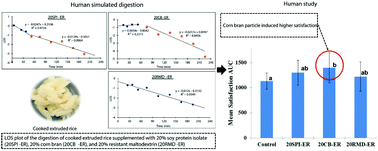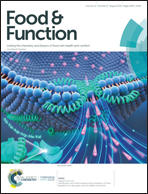Starch digestion kinetics of extruded reformed rice is changed in different ways with added protein or fiber
Abstract
White rice is considered a high glycemic index (GI) food and extruded reformed rice offers the opportunity to design a lower GI product. This study tested the effect of added soy protein isolate (SPI) or dietary fibers [corn bran (CB), resistant maltodextrin (RMD)] to delay in vitro digestion, and on human gastric emptying rate and satiety scoring. Starch digestion using a human simulated system showed a single-phase kinetic pattern for regular reformed rice and two-phase kinetic patterns for 20% supplemented extruded rice, which lowered the estimated glycemic index (eGI). For 20% SPI extruded rice (20SPI-ER), the first-phase rate constant (k1) of cooked extruded rice was higher than its second-phase (k2). Conversely, for 20% corn bran extruded rice (20CB-ER), a low value of k1 and high for k2 and C∞2 were found. The 20% RMD extruded rice (20RMD-ER) and the control exhibited a single-phase kinetic digestion with similar k values. The end-point of the second-phase digestion (C∞2) and the eGI of cooked 20SPI-ER were lower than for fiber addition. These differences were speculated to be due to the heterogeneous matrices of the SPI and CB incorporated kernels, opposed to the homogeneous matrices of the RMD and control. Thus, extruded rice compositions were found that resulted in different starch digestion kinetics [single phase and two-phase (k1/k2) high/low, low/high] and were medium eGI with added protein or fiber. Compared to the control, only 20RMD-ER had lower gastric half-emptying time and 20CB-ER had higher subject satisfaction.



 Please wait while we load your content...
Please wait while we load your content...